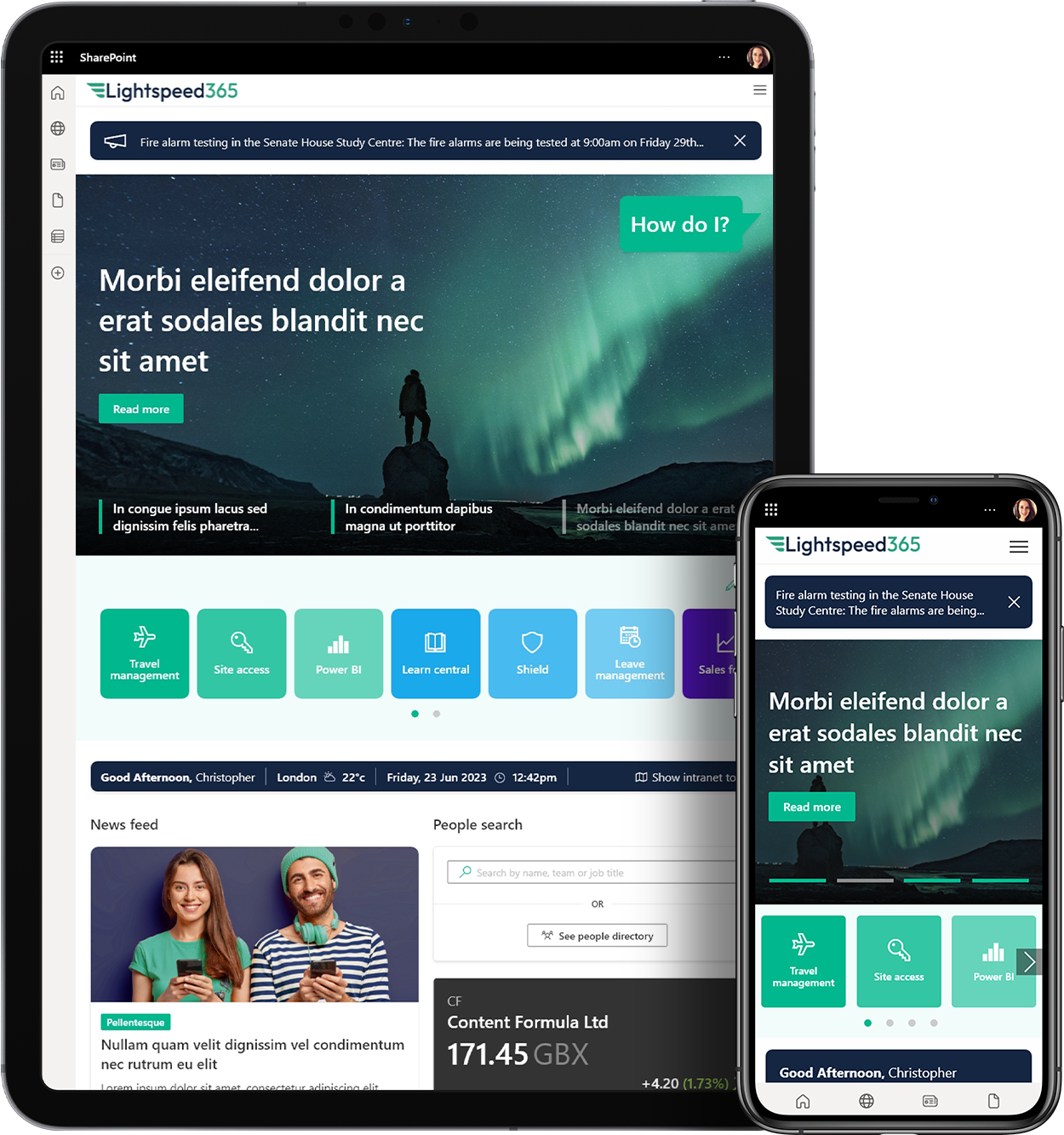How an intranet can help with Office 365 governance
Office 365, SharePoint and intranet governance are big topics that weve previously featured in this blog. Effective governance is essential for the success of your platform and covers many areas including:
- senior sponsorship and decision making
- technical standards
- data management
- the content lifecycle
- legal and regulatory considerations
- design and branding
- and more!
Governance of the use of tools
One aspect of Office 365 governance which many digital workplace teams are currently grappling is with around the use of different tools within the enterprise. In any given organisation there are a plethora of applications in use, with:
- some centrally supported and encouraged
- some owned within specific departments and lines of business and not centrally supported
- tools which are actively discouraged because they provide less value, are costly duplicates of tools already in use or are risky (Shadow IT)
Office 365s ever-expanding library of tools, applications and capabilities provides one of the best strategies to cut down on wasteful and risky shadow IT because it provides effective alternatives to those in use. It also helps replace ancient legacy applications. You cant tell users to stop using a system unless there is a decent official alternative. If you want to reduce the use of Dropbox, Whats App and the creaking custom-built telephone book then One Drive, MS Teams, Skype for Business and Delve are the way to go.
However, the plethora of Office 365 tools can also lead to another dilemma for digital workplace teams. Often the pace of new tools being added is faster than the ability for central teams to properly evaluate use, launch them and then carry out effective training and support. And some Office 365 tools when released in beta need time to mature before they are truly enterprise-ready. Therefore, a key Office 365 governance issue is deciding on which tools to roll out to users and support, and which ones to lock down.
In our experience Office 365 governance is best approached with carrots rather than sticks. Creating positive and valuable experiences for the tools that you want employees to use is the best way to advance a set of centrally-supported tools. Then you need to do far less work on the discouragement or locking down of the tools you dont want people to use.
The intranet can help!
An excellent way to drive use of certain types of tools is through a SharePoint intranet which effectively acts as a gateway and experience layer lying on top of the Office 365 tool suite. Using an intranet helps to:
- Drive a better experience, creating positive and valuable experiences of tools such as MS Teams which underpins successful usage
- Integrates tools into the flow of work: brings the use of tools into the flow of work so they become the natural applications to use
- Makes some tools easier to access and some less so, encouraging use and reminding employees about the tools they should be using
- Helps with support and training by highlighting good use and providing support on how to use these tools
- Support an approach to experiment with tools which have not yet been rolled out fully, supporting a framework to experiment and valuate new Office 365 tools
Lets look at each of these aspects in more detail.
A better experience
A good user experience is not generally regarded as a governance tactic, but it will have more impact than creating a policy document. Ultimately, outside the use of Outlook and the core Office suite, the use of most of the Office 365 suite is not mandatory, and therefore you have to persuade employees to use your preferred tool rather than another.
Sometimes an intranet, particularly a SharePoint-based product like Wizdom, presents a superior interface to the Office 365 tools, and encourages use. Dont underestimate the importance of a nice look and feel in driving adoption and underpinning governance.
Integrates tools into the flow of work
Intranets have evolved into digital workplaces, acting as gateway into the wider suite of tools, including those from Office 365. An intranet can integrate data and content from different Office 365 tools and provide access to them through dashboards, workspaces and profiles, helping to make these applications the tools of choice.
For example, a Yammer feed in an intranet workspace with all your community members makes that the natural tool to use for community discussions. If Skype for Business is integrated into your employee directory, employees may use that tool to message the colleague theyve just looked up. And with AD integration, single sign-on also removes a barrier to using these tools. Integrating the core Office 365 tools with your intranet directly supports your governance model.
Make some tools easy to access and others less so
Above integrating preferred tools, there are other ways an intranet can make some applications easier to access and others less so. These include:
- Providing access to selected tools via your global navigation
- Providing favourite links to applications on the homepage, perhaps using prominent icons
- Creating a service catalogue with supported tools (and sometimes allowing users to add to their own favourite links from here)
- Providing feeds from different tools or lists of different sites relating to tools from your own homepage e.g. a list of Team Sites an employee is a member of, a Yammer feed etc.
- Providing landing pages with a list of all the sites a person is a member of. For example, we recently integrated a page for a client where an employee can find all the Teams they are a member of.
- Providing a form to request a new team space, site, group or community
All of the above heavily encourage use of preferred tools. Excluding the tools in the Office 365 suite which are not yet rolled out will help to limit their use.
Helping with support and training
Encouraging the use of preferred Office 365 tools is also supported by providing training and support resources via the intranet. For example, you could have a what to use when matrix which indicates the optimum digital tool or channel to use for which scenarios.
You can also have specific training resources including how to guides and videos, and even support communities which include intranet teams, site administrators, IT helpdesk and knowledgeable users. Here people can ask questions and swap tips. Again, this reinforces the use of the right tools to dissuade users from using alternatives.
Drive an approach to experiment with tools
While you are likely to want to lockdown some of Office 365, you may also want to encourage some experimentation or pilots with newer tools to help you evaluate their use before they get fully rolled out to the company. This also helps you to allow early adopters and mavericks to use tools they are keen to try, but in a more controlled environment.
Sometimes it pays to formalise an approach to piloting new tools on the Office 365 roadmap and bake that into your governance model. The intranet can help with this approach. For example, you may have a community which pilots tools and you may use the intranet to give them access the tool and collate their feedback. Of course, once a tool becomes fully supported you can then open this up to be a full support community with the appropriate support resources also available.
Use carrots, not sticks
Controlling the use of Office 365 tools is a challenge and it needs governance. We believe the carrot approach to encourage use of the tools you want employees to use is the best approach. Telling employees that they cannot use a tool because it is not yet supported does not always go down well.
An intranet can really help with the carrot approach by integrating tools so that they have value and also providing the right support. Office 365 is a fantastic and exciting platform, and a SharePoint intranet complements it perfectly.



 SharePoint Products
SharePoint Products

